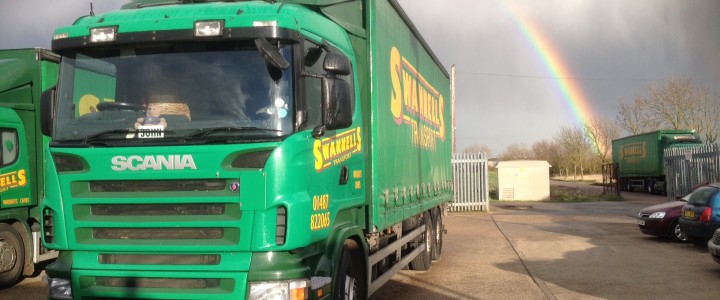
Without roads, there would be very little organisation and less safety in driving a vehicle. Additionally, they are highly important to businesses within the haulage, warehousing and delivering industry etc. As a haulage company in Cambridgeshire, we are interested more interested in roads than the average Joe.
That is why we have created this article which discusses some of the UK’s road records.
How Do Roads Affect Haulage?
This is essentially an obvious one – roads are built to create complete organisation and safety for the public, ensuring there are standard, allocated routes for vehicles to drive through towns, cities and countrysides etc. In terms of haulage, our HGV and other used vehicles rely on the roads to deliver goods to customers within the right time frame and of course, safely!
The Top 3 Longest Roads In The UK?
So, what and where are the longest roads in the UK? And how long are they?
3. A30 – this road leads from Land’s End, Cornwall all the way to London. It is approximately 457km, which is 284 miles!
2. A38 – this road leads from Bodmin, Cornwall to Mansfield in Nottinghamshire! With a length of 498.6km (309.8 miles), you would be on this road for ever!
1. A1: Probably the most well-known road in the country, this leads from Central London to Central Edinburgh, which is an extraordinary distance of 396 miles (637km)!
The Top 3 Longest Motorways In The UK?
A motorway is a road that only allows motorised vehicles and permitted drivers onto it. Therefore, no pedestrians or cyclists can enter onto the motorway road. Here are the 3 longest motorways in the UK:
3. M4: This motorway runs from Chiswick, London to Post Abraham, Carmarthenshire. This is probably the only road in this blog that includes a little bit of Welsh region, the M4 travels from West London all the way down to South Wales, which is more or less the whole width of the lower UK! With a massive length of 191.9 miles, this motorway is particularly busy during the Summer peak season.
2. M1: Linking London to Yorkshire, the M1 remains one of the key road connections in the UK. With a length of 200 miles, this motorway begins at Staples Corner and makes it’s way through Milton Keynes, Leicester, Sheffield and Leeds.
1. M6: The longest motorway in the UK, the M6 has an outstanding stretch of 236 miles. Starting in Catthorpe in Leicestershire and ending in Dumfriesshire, this motorway is not only the longest, but it is also the oldest and probably most important connection in the UK.
The Top 3 Most Congested Roads In The UK?
Believe it or not, but road congestion is one of the most expensive road situations in the economy. Costing nearly £8bn annually, drivers are losing a lot of money each year from just sitting in traffic. So, what are the most congested roads in the UK?
3. A34: This road stretches from Highfield Road to Highgate Middleway, which are both in Birmingham. This road has been proven to waste approximately 44 hours a year, which is genuinely a significant amount of time and money.
2. Saltaire Road: Located in Leeds, this road links Harrogate Road to Bradford Road, where again, approximately 44 hours of time, money and petrol is wasted.
1. A406: From Chiswick Roundabout to Hanger Lane, in West London, is believed to be the most congested road in the UK, wasting an average of 61 hours a year.
As a haulage company in Cambridgeshire, who deal with deliveries and transport services, it should come as no surprise that we deal with traffic every once in a while! Make sure you keep safe & alert whilst sat in traffic.

Other Facts Of The Roads
- The steepest sign-posted road in the UK is located in the Snowdonia National Park. The road is called Ffordd
pen Llech and has a maximum gradient of 36.63% (we wouldn’t recommend cycling up here!). - On the 5th
April, 1985, there was a huge traffic jam on the M1 that was 40 miles long! - Elgin Street in Bacup is not only the UK’s shortest road, but it is also the world’s shortest road! Measured at 5.2m in length.
- The highest road in the UK is a private lane in Cumbria. With a 847m altitude, the road leads to an Air Traffic Control Installation, so it is put into good use! A permit is required to drive on it.
- The A1123 is claimed as the bumpiest road in the UK! The road joins Haddenham to
Earith and even after being closed for five weeks surface improvement, it’s still claimed to be a risky road.
How To Prepare For A Trip With These Roads?
It doesn’t necessarily have to involve one of the roads I have listed above, but any long, congested or potentially dangerous road should be taken with care, and there are plenty of ways you can do so:
- Prepare a safety kit in your car incase anything goes wrong. This includes petrol, water, spare coat, oil or any other car essentials.
- Clean your car! This might not necessarily make it safer, but it will put you in a much better mood, more motivated to drive safely and concentrate.
- Be sure to check out our blog, ‘How To Enjoy A Long Journey’ for a complete guide on safely entertaining yourself during your drive.
- Be aware of all dangerous or congested roads you may approach during your journey. You can find this out by plotting your journey into your Maps app before you leave. The majority of these apps show you any construction or temporary traffic going on nearby and on your route.
We are a Haulage Company in Cambridgeshire…
Offering general haulage, hazardous freight, warehousing and transport services, Swannells Transport are a haulage company in Cambridgeshire here for all of your haulage needs. Get in contact with us today to start your journey!
Alternatively, for more information about us, like Swannells Transport’s Facebook Page for daily news and updates!
Thanks for reading.



